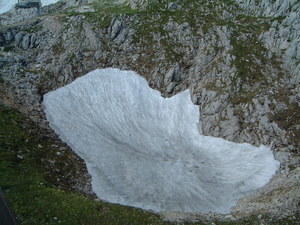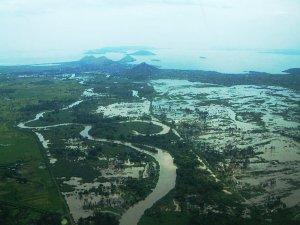Theories
Increase in temperature can cause the melting of glacials, Austria
Image Credit: C. H. Jen, 2003
Increase in rainfall and deforestation can cause flooding, Kenya
Image Credit: UNEP/Government of Kenya, 2003
Climatologists reporting for the UN Intergovernmental Panel on Climate Change (IPCC) indicate that there is global warming caused by human activities and there are growing fears of feedbacks that will accelerate this warming. The IPCC was established in 1988 by the World Meteorological Organization and the UN Environment Programme. The IPCC is responsible for providing the scientific and technical foundation for the United Nations Framework Convention on Climate Change (UNFCCC), primarily through the publication of periodic assessment reports (see "Second Assessment Report" and "Third Assessment Report"). In IPCC usage, climate change refers to any change in climate over time, whether due to natural variability or as a result of human activity. In UNFCCC usage, climate change refers to a change in climate that is attributable directly or indirectly to human activity that alters atmospheric composition.
Green house gas emissions have increased considerably due to the consumption of fossil fuels and changes in the land surface. Recent analysis indicate that the earth as a whole has warmed by about 0.3-0.6 °C over the past century. It is expected that this rate will increase significantly to 0.5 –1.0 °C per decade through the next few decades, if human activities, which emit green house gases, continue. Scientists have predicated that global warming will continue in the future if the environment is not managed in a sustainable manner.
There still a lot of research on global warming, however, the nature and causes of climate change are still not well understood. There are several theories that explain the climate change phenomena including; the Milankovitch Theory which describes the relationship between the sun and the earth and the Astronomical Theory. The warming will not be globally uniform but will differ significantly between geographical regions. In addition, the warming may vary between seasons. As a result, the altered temperature gradients will change the pattern of winds and precipitation distribution regionally. The details of these localised changes are not clearly understood. It is expected, however, that the interiors of continents will shift displacing current patterns of agricultural production. People are causing the change by accelerated burning nature's vast stores of coal, oil and natural gas. These processes can release billions of tonnes of carbon dioxide (CO2) every year, altering the composition of the atmosphere and it chemical and physical behaviours, because CO2 is a greenhouse gas that traps the Sun's radiation within the troposphere, the lower atmosphere. It has accumulated along with other man-made greenhouse gases, such as methane and chlorofluorocarbons (CFCs). If current trends continue, we will raise atmospheric CO2 concentrations to double pre-industrial levels during this century. That will probably be enough to raise global temperatures by around 2°C to 5°C. Some warming is certain, but the degree will be determined by feedbacks involving melting ice, the oceans, water vapour, clouds and changes to vegetation.
 Stop and Think!
Stop and Think!
Explain the theories of climate change.

